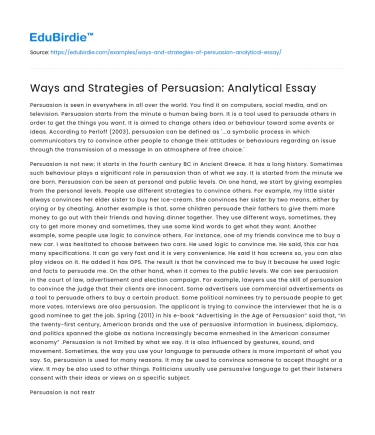Introduction
Persuasion is a pivotal tool in various domains such as marketing, politics, and personal relationships. It involves the art of influencing others' beliefs, attitudes, or behaviors through argument, reasoning, or the appeal to emotion. Historically, persuasion has been studied extensively, with techniques evolving from Aristotle's rhetorical appeals to modern psychological approaches. Understanding the underlying strategies of persuasion is crucial not only for those who wish to influence others but also for those who aim to resist undue influence. This essay explores the different ways and strategies of persuasion, analyzing their effectiveness through theoretical frameworks and real-life applications. By examining both classical and contemporary techniques, this analysis aims to provide a comprehensive understanding of persuasive methods and their implications.
Classical Rhetorical Strategies
Classical rhetorical strategies, as outlined by Aristotle, continue to form the foundation of persuasive communication. These strategies are ethos, pathos, and logos—each serving a distinct purpose in the art of persuasion. Ethos refers to the credibility and ethical character of the speaker or writer. Establishing ethos involves demonstrating expertise and trustworthiness, which enhances the persuasive appeal. For instance, a physician advocating for vaccination is more likely to persuade the public due to their perceived authority in health matters.
Save your time!
We can take care of your essay
- Proper editing and formatting
- Free revision, title page, and bibliography
- Flexible prices and money-back guarantee
Pathos, on the other hand, appeals to the audience's emotions. Emotional engagement can be a powerful motivator, as seen in charity campaigns that use heart-wrenching images and stories to elicit sympathy and prompt donations. However, reliance on pathos can lead to manipulation, raising ethical concerns about exploiting emotions for persuasive ends (Cialdini, 2001).
Logos involves logical reasoning and the use of evidence to support arguments. This strategy is effective in persuading audiences who prioritize rational analysis over emotional or ethical appeals. In academic writing, for example, the use of statistics, studies, and factual information enhances the argument's credibility. Despite its strengths, logos may fall short in engaging audiences who are more influenced by emotional or ethical factors.
Transitioning from classical to contemporary strategies, it is important to recognize that while ethos, pathos, and logos remain relevant, modern persuasion often integrates these with psychological insights to adapt to the complexities of contemporary audiences.
Psychological Approaches to Persuasion
In the realm of psychology, persuasion is viewed through the lens of cognitive and social processes. The Elaboration Likelihood Model (ELM) proposed by Petty and Cacioppo (1986) offers a dual-route approach to persuasion. The central route involves careful and thoughtful consideration of the arguments presented, while the peripheral route relies on superficial cues, such as the attractiveness of the speaker. This model suggests that the effectiveness of a persuasive message depends on the audience's motivation and ability to process information.
Social proof, a concept popularized by Cialdini, is another psychological strategy that leverages the human tendency to conform to the behavior of others. Real-world applications include online reviews and testimonials, which influence consumer behavior by suggesting that if others find a product valuable, it must be worthwhile. While effective, the reliance on social proof can lead to herd mentality, reducing individual critical thinking (Cialdini, 2001).
Another psychological tactic is scarcity, which capitalizes on the fear of missing out. Marketers often use phrases like "limited time offer" to create urgency, prompting consumers to act quickly. This strategy exploits the perception that scarce items are more desirable, thus enhancing their value. However, overuse of scarcity tactics may lead to consumer skepticism and diminish their impact over time.
Transitioning to the final section, it is necessary to address the ethical implications of these persuasive strategies and consider counter-arguments that highlight the potential for manipulation and exploitation.
Ethical Considerations and Counter-Arguments
While persuasive strategies can be highly effective, they also raise significant ethical questions. The potential for manipulation is a primary concern, especially when persuasion exploits emotional vulnerabilities or cognitive biases. For instance, the use of fear in political campaigns can lead to misinformation and division, undermining democratic processes. Critics argue that ethical persuasion should prioritize transparency and respect for the audience's autonomy, allowing individuals to make informed decisions without undue influence.
Counter-arguments to the pervasive use of persuasion emphasize the importance of critical thinking and media literacy as tools for resistance. Educating individuals to recognize persuasive techniques can empower them to evaluate arguments more critically and reduce susceptibility to manipulation. Moreover, ethical guidelines for persuasive communication, particularly in advertising and media, can help balance the power dynamics between persuaders and their audiences.
Despite these concerns, it is important to acknowledge that persuasion, when used ethically, can lead to positive outcomes, such as promoting public health initiatives or encouraging pro-social behavior. Thus, the challenge lies in developing strategies that are both effective and respectful of individual autonomy and societal values.
Conclusion
In conclusion, the art of persuasion encompasses a diverse array of strategies, from classical rhetorical techniques to modern psychological approaches. Each method offers unique advantages and challenges, with their effectiveness often contingent on the audience and context. While persuasion can be a force for positive change, it also poses ethical dilemmas that necessitate careful consideration. By understanding the mechanics of persuasion and promoting ethical practices, individuals and organizations can harness its power responsibly, fostering informed decision-making and constructive dialogue. As society continues to evolve, so too must our approaches to persuasion, ensuring they align with both contemporary challenges and ethical standards.






 Stuck on your essay?
Stuck on your essay?

